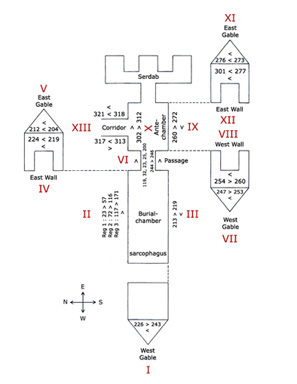The
Pyramid Texts of UNAS

by Wim
van den Dungen
Burial-Chamber
l
Passage-way
l
Antechamber
l
Corridor
introduction
l
English text
l plan
of the tomb l
commentary
XIV
Serdab

THE HOUSE OF
OSIRIS
Sethe's Edition
l
Translation
l
Central Plan
In the East of the antechamber, a doorway opens to the undecorated and uninscribed
tomb-chapel
with three recesses. Egyptologists are not sure about the role of this triple
chamber, the so-called "serdab" or "cellar". Two views persist. Either the
serdab was used to install the Ka and Ba statues of the king (Spiegel,
1971), or it symbolised the "House of Osiris", the place to perform the
rites of death & resurrection of Osiris (Mathieu,
1997).
In the funerary domain, the sitting statue is attested from the
Early Dynastic Period onwards. It is the three-dimensional realization of
the picture of the Slab-stela, representing the enthroned tomb owner in
front of an offering table, to which he is stretching out one hand. The
stretched (mostly right) hand is shown resting on the thigh, the left hand
often on the breast (but variants in gesture and garment exist). During
the IVth Dynasty, the sitting statue is a formal part of the Giza
cemetery. It was placed in a closed "serdab" (the Arabic for "cellar"). In this "inner" cult place, the
Ka-statue is the
"double" of the tomb owner, representing the latter as corporally intact,
provided and able to receive provisions (a) by way of the mummy enshrined in
the sarcophagus, and (b) through the offerings made to the Ka. A pleased
Ka gratifies the Ba, who then visits the place and recognizes his or
her own image in the Ka-statue empowered by its Ka. It is also in this
context interesting to note how the East Wall of the wordless chamber
parallels the sanctuary of the mortuary temple, with its false door on its
West Wall. Indeed, the middle recess of this tomb-chapel lies exactly
behind the false door of the sanctuary above.
Only in the pyramid of Teti, who reigned after Unas, are the walls of the
opening to the serdab not uninscribed. They refer to the resuscitation of
Osiris, the re-membering of his body, being clothed and
anointed.
Mathieu (1997) brought together textual
evidence from a wide range of sources to support the thesis the
serdab was the "House of Osiris". The fact of it being not inscribed
would have given
it an additional "potential", playing the role of place of regeneration.
To support this hypothesis, a comparison between the distribution of texts
in the pyramids of Unas, Teti, Pepi I, Merenre & Pepi II becomes
necessary. The West Wall of the burial-chambers of Pepi I, Merenre & Pepi
II is inscribed, whereas that of Unas and Teti is not. A significant part
of these texts deal with precisely the themes found in the opening between
the tomb-chapel and the antechamber in the pyramid of Teti, namely the
resuscitation, remembering and reclothing of the king as an awakened
Osiris ... This points to an Osirian theme.
Naydler (2005) brings the evidence
together by suggesting that after Unas
and Teti, the most esoteric (read : Osirian) texts (concerned with initiatory rites of death
and rebirth), were inscribed in the areas left uninscribed in their pyramids,
namely the West Gable directly above the sarcopagus.
In this context, let us also consider the architectonic connection with
the pyramid-complex and its Ka-service. Suspending the funerary
interpretation of the pyramid-complex implies that the latter becomes a
mortuary temple only after the burial of the king. Before that crucial
moment, the pyramid complex may have serviced royal rituals like the Sed
festival.
In the mortuary temple, the sem-priests would daily renew the vitality of
the Ka of the divine king through (voice) offerings and rituals. This
activity could continue for centuries after his burial. At the end of the
funerary rituals, the vital connection between the spiritual principles of
the divine king (Akh) and his movement up and dawn the ladder (Ba) had
been realized. In the ongoing service for the deceased, the priest
addressed his Ka by offerings. The "subtle" or vital energy released by
these physical things fed this Ka and attracted the Ba into the ritual
cycle via the mummy (the consecrated body) and the "sah" (the
ritual body).
If the sarcophagus (with the mummy) is seen as the Western "entry"-point
of the dying god (Nut swallowing the Sun), then the serdab is the
"exit"-point of the Ba joining the royal Ka and be gratified by its
plenty. The Eastern end of the tomb joins its Western end (cf. the
Oroboros-serpent). The serdab leads to the sanctuary above. Maybe the
three statues represented king Unas (in the middle), his Ka (North - cf.
Offering Liturgy) and his Ba (South - cf. Duat Voyage) ? In this
hypothesis, the serdab joins the burial-chamber, situating the antechamber
at the heart of the architecture, separating the horizon from the workings
of day (mortuary temple) and night (serdab and sarcophagus-room). The
wordless chamber is thus a direct stairway to the Ka-magic of the rituals
performed above. This is the way and privilege of the Osirian King, who
comes and goes as he pleases.
|

![]()
